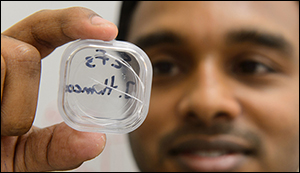Weird material shrinks when warm
14. 10. 2015 | UCONN | today.uconn.edu
Most materials swell when they warm, and shrink when they cool. But UConn physicist Jason Hancock has been investigating a substance that responds in reverse: it shrinks when it warms.
Although thermal expansion, and the cracking and warping that often result, are an everyday occurrence - in buildings, bridges, electronics, and almost anything else exposed to wide temperature swings - physicists have trouble explaining why solids behave that way.

Research by Hancock and his colleagues into scandium trifluoride, a material that has negative thermal expansion, recently published in Physical Review B, may lead to a better understanding of why materials change volume with temperature at all, with potential applications such as more durable electronics.
The classical way to think about solids like glass, metal, and rock imagines them made of atoms hooked together by springs. The springs stretch and flex in response to heat. But because each spring, when it expands, puts pressure on its neighboring springs - and all those neighboring springs expand the same amount and exert the same pressure on the first spring and all their own neighboring springs - the forces they exert on each other should be symmetrical, and the material should neither expand nor contract.
Read more at UCONN
Image Credit: UCONN
-jk-




